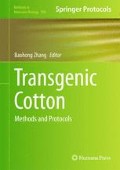Abstract
Genetic transformation of cotton (Gossypium hirsutum L.) is highly dependent on the ability to regenerate fertile plants from transgenic cells through somatic embryogenesis. Induction of embryogenic cell cultures is genotype dependant. However, once embryogenic cell cultures are available, they can be effectively used for transformation by Agrobacterium or biolistic bombardment methods. Here I describe a detailed procedure to transform cotton embryogenic cell suspension cultures by biolistic bombardment. A commercially available, helium-driven biolistic device (Bio-Rad PDS1000/He) was used to bombard gold particles coated with plasmid DNA (for visual identification of transformed cells and/or selection) into embryogenic cells. Stable transformation at a high frequency (up to 4% of the transiently expressing cells) is possible. Regeneration of fertile transgenic plants from embryogenic cells takes only about 2 months. Another advantage of the embryogenic cell suspension cultures is that they are amenable for cryopreservation and long-term storage. It is highly preferable to transform commercial varieties of choice than obsolete varieties to avoid the genetic drag due to backcrossing.
Access this chapter
Tax calculation will be finalised at checkout
Purchases are for personal use only
References
Wilkins TA, Rajasekaran K, Anderson DM (2000) Cotton biotechnology. Crit Rev Plant Sci 19:511–550
James C (2011) Annual biotech crop report by International Service for the Acquisition of Agri-biotech Applications (ISAAA). Available at http://www.isaaa.org/
Trolinder NL, Xhixian C (1989) Genotype specificity of the somatic embryogenesis response in cotton. Plant Cell Rep 8:133–136
Rangan TS, Rajasekaran K (1996) Regeneration of cotton plants in suspension culture. US Patent 5,583,036
Rajasekaran K, Grula JW, Hudspeth RL, Pofelis S, Anderson DM (1996) Herbicide-resistant Acala and Coker cottons transformed with a native gene encoding mutant forms of acetohydroxyacid synthase. Mol Breed 2:307–319
Zhang B-H, Liu F, Yao C-B (2000) Plant regeneration via somatic embryogenesis in cotton. Plant Cell Tissue Organ Cult 60:89–94
Rajasekaran K (2004) Agrobacterium-mediated genetic transformation of cotton. In: Curtis IS (ed) Transgenic crops of the world essential protocols. Kluwer Academic Publishers, Dordrecht, The Netherlands, pp 243–254
Leelavathi S, Sunnichan VG, Kumria R, Vijaykanth GP, Bhatnagar RK, Reddy VS (2004) A simple and rapid Agrobacterium-mediated transformation protocol for cotton (Gossypium hirsutum L.): embryogenic calli as a source to generate large numbers of transgenic plants. Plant Cell Rep 22:465–470
Wu J, Zhang X, Nie Y, Luo X (2005) High-efficiency transformation of Gossypium hirsutum embryogenic calli mediated by Agrobacterium tumefaciens and regeneration of insect-resistant plants. Plant Breed 124:142–146
Wu S-J, Wang H-H, Li F-F, Chen T-Z, Zhang J, Jiang Y-J, Ding Y, Guo W-Z, Zhang T-Z (2008) Enhanced Agrobacterium-mediated transformation of embryogenic calli of upland cotton via efficient selection and timely subculture of somatic embryos. Plant Mol Biol Rep 26:174–185
Obembe OO, Khan T, Popoola JO (2011) Use of somatic embryogenesis as a vehicle for cotton transformation. J Med Plant Res 5:4009–4020
Finer JJ, McMullen MD (1990) Transformation of cotton (Gossypium hirsutum L.) via particle bombardment. Plant Cell Rep 8:586–589
Rajasekaran K, Hudspeth RL, Cary JW, Anderson DM, Cleveland TE (2000) High-frequency stable transformation of cotton (Gossypium hirsutum L.) by particle bombardment of embryogenic cell suspension cultures. Plant Cell Rep 19:539–545
Rajasekaran K (1996) Regeneration of plants from cryopreserved embryogenic cell suspension and callus cultures of cotton (Gossypium hirsutum L.). Plant Cell Rep 15:859–864
Christou P (1996) Particle bombardment for genetic engineering of plants. R. G. Landes Company and Academic Press, Austin, TX, p 199
Klein TM, Gradziel T, Fromm ME, Sanford JC (1988) Factors influencing gene delivery into Zea mays cells by high-velocity microprojectiles. BioTechnology 6:559–563
Beasley CA, Ting IP (1973) The effects of plant growth substances on in vitro development from fertilized cotton ovules. Am J Bot 60:130–139
Murashige T, Skoog F (1962) A revised medium for rapid growth and bioassays with tobacco tissue cultures. Physiol Plant 15:473–497
Jefferson RA (1987) Assaying chimeric genes in plants: the GUS gene fusion system. Plant Mol Biol Rep 5:387–405
Kosugi S, Ohashi Y, Nakajima K, Arai Y (1990) An improved assay for β-glucuronidase in transformed cells: methanol almost completely suppresses a putative endogenous β-glucuronidase activity. Plant Sci 70:133–140
Firoozabady E, DeBoer DL (1993) Plant regeneration via somatic embryogenesis in many cultivars of cotton (Gossypium hirsutum L.). Vitro Cell Dev Biol Plant 29:166–173
Trolinder NL, Goodin JR (1987) Somatic embryogenesis and plant regeneration in cotton (Gossypium hirsutum L). Plant Cell Rep 6:231–234
Davidonis GH, Hamilton RH (1983) Plant regeneration from callus tissue of Gossypium hirsutum L. Plant Sci Lett 32:89–93
Gawel NJ, Rao AP, Robacker CD (1986) Somatic embryogenesis from leaf and petiole callus cultures of Gossypium hirsutum L. Plant Cell Rep 5:457–459
Author information
Authors and Affiliations
Corresponding author
Editor information
Editors and Affiliations
Rights and permissions
Copyright information
© 2013 Springer Science+Business Media New York
About this protocol
Cite this protocol
Rajasekaran, K. (2013). Biolistic Transformation of Cotton Embryogenic Cell Suspension Cultures. In: Zhang, B. (eds) Transgenic Cotton. Methods in Molecular Biology, vol 958. Humana Press, Totowa, NJ. https://doi.org/10.1007/978-1-62703-212-4_5
Download citation
DOI: https://doi.org/10.1007/978-1-62703-212-4_5
Published:
Publisher Name: Humana Press, Totowa, NJ
Print ISBN: 978-1-62703-211-7
Online ISBN: 978-1-62703-212-4
eBook Packages: Springer Protocols

